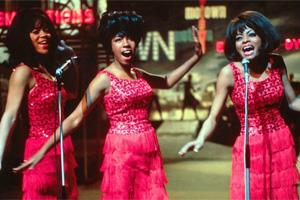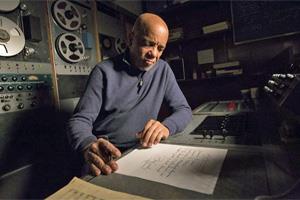
Showtime’s new documentary on the legendary Motown record label sometimes plays as if the Wayans brothers should be standing in for the lead characters.
A striking percentage of Hitsville: The Making of Motown, which premieres Saturday at 9 p.m. ET, consists of Motown pillars Berry Gordy (top) and Smokey Robinson (top) batting compliment back and forth like a ping-pong ball.
“You da man!” “No, you da man!” “No, you da man!” “No, you definitely da man!” And so on.
It’s not that they’re wrong. Berry Gordy Jr., who founded the label, and Smokey Robinson, one of its central creative beacons, became and remain towering presences in modern American popular music.
 Motown at its peak, with songs like “My Girl,” “Tracks of My Tears,” “I Can’t Help Myself,” “I Heard It Through the Grapevine” and “Dancing In the Streets,” was to the 1960s what Irving Berlin and Cole Porter were to the ‘30s. It takes nothing from the British bands of the ‘60s to say Motown was their match, blending powerhouse R&B, gospel, pop, and even the occasional odd country riff.
Motown at its peak, with songs like “My Girl,” “Tracks of My Tears,” “I Can’t Help Myself,” “I Heard It Through the Grapevine” and “Dancing In the Streets,” was to the 1960s what Irving Berlin and Cole Porter were to the ‘30s. It takes nothing from the British bands of the ‘60s to say Motown was their match, blending powerhouse R&B, gospel, pop, and even the occasional odd country riff.
Motown didn’t agonize over pristine technical sound perfection. Motown went for music that sounded great when you blasted it from the speakers of one of those beautiful cars that were rolling off the assembly line in other corners of Detroit.
While Hitsville is hardly the first documentary on Motown, it’s being sold as the first made with Gordy’s cooperation and participation. Much of the two hours jumps off from his reminiscences on how it all began.
He’d always had an entrepreneurial spirit, he says, and since he loved music, he opened a record shop. It failed, he says in retrospect, because he was trying to persuade customers to buy high-quality jazz albums – his personal favorites – when they wanted Muddy Waters.
Serving the listener was his takeaway from that bust, he says. Then he worked on an auto assembly line, and his takeaway there was that you could run a record company on assembly line principles. A department for finding talent. For polishing talent. For writing songs. For training artists in stage presence. For recruiting backup musicians. No detail too small.
He was told an enterprise involving artists could never be that regimented, that it would lose its spark. He proved them wrong.
 Partly because Motown was first seen as a tiny black label that could never be a major player, Gordy kept control of everything. He hired people like Robinson, Norman Whitfield, Mickey Stevenson and the writing team of Holland-Dozier-Holland. His scouts found artists and gave them time – in the case of the Supremes (right), years – to develop.
Partly because Motown was first seen as a tiny black label that could never be a major player, Gordy kept control of everything. He hired people like Robinson, Norman Whitfield, Mickey Stevenson and the writing team of Holland-Dozier-Holland. His scouts found artists and gave them time – in the case of the Supremes (right), years – to develop.
Gordy also personally had great ears. Hitsville digs out the original concept for Marvin Gaye’s “Stubborn Kind of Fellow” and traces how Gordy turned it from a minor jazz riff into a great pop record. He did the same for the Miracles’ “Shop Around.”
Hitsville takes Motown through its best years, from its founding in the early 1960s through the early 1970s, when Gordy moved it to Los Angeles to get a foothold in the movie business.
A lot of artists and fans think he left much of the magic behind in Detroit, and there’s a strong case to be made for that.
Hitsville wouldn’t say that. What it does acknowledge is Gordy’s gradual and reluctant acceptance of the idea that Motown songs could reference the troubled world around them.
That was a big shift since Gordy for years only wanted music people could sing along with or dance to. He also wanted it color-neutral. Not by accident did he call Motown “the sound of young America,” as inclusive and exhilarating a slogan as the music business has ever put forward.
An extended segment here recounts how Gaye had to browbeat Gordy into releasing Gaye’s socially conscious “What’s Going On,” today widely considered a record that belongs on popular music’s Mount Rushmore.
 No doubt because of Gordy’s involvement, Hitsville doesn’t address many elements that are part of the broader Motown story. A number of artists claimed in later years that they didn’t receive fair royalties. There were questions about why Motown didn’t report its sales to the recording industry’s trade group. Some artists left or never joined Motown because they felt the Gordy system would stifle their voices.
No doubt because of Gordy’s involvement, Hitsville doesn’t address many elements that are part of the broader Motown story. A number of artists claimed in later years that they didn’t receive fair royalties. There were questions about why Motown didn’t report its sales to the recording industry’s trade group. Some artists left or never joined Motown because they felt the Gordy system would stifle their voices.
Historically, it’s a serious omission that Hitsville ignores the rich music tradition Detroit built before Motown. Figures like Joe Von Battle need to be acknowledged, and anyone who likes Smokey Robinson’s singing needs to hear the voice he inherited it from, the great Nolan Strong of the Diablos from Detroit’s Fortune Records.
All that is and needs to be part of the full Motown story.
Hitsville, though, sticks to the hits, and while that doesn’t make it definitive, that’s okay. It celebrates the part of the story that fans remember and cherish the most.
We meet Maxine Powell, who was hired to teach stage etiquette to singers who didn’t look joyful enough when they sang. We hear how Stevie Wonder knocked everyone out on his first visit at the age of 11. We hear how the Supremes were matched up with “Where Did Our Love Go” because the Marvelettes wouldn’t sing it.
In the end, it’s an upbeat two hours, filled with great songs and making a good case that the Motown story is the American dream set to music.